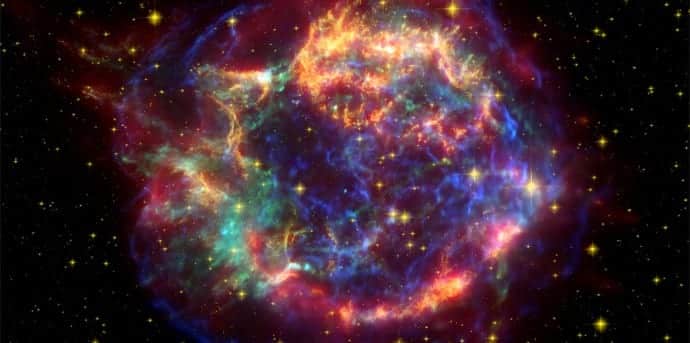NASA captures exploding star’s shockwave with Kepler space telescope for the first time
For the first time using NASA’s planet-hunting Kepler Space Telescope, astronomers have captured evidence of ‘shock breakouts,’ or bright flashes that occur when red stars become supernovas. The blast, which travels at more than 89 million miles per hour (40,000 km/s), lasts for just a few minutes as the star explodes.
The team led by Peter Garnavich, astrophysics professor at the University of Notre Dame in Indiana, analysed light captured by Kepler every 30 minutes over a three-year period from 500 distant galaxies, searching some 50 trillion stars. They were hunting for signs of massive stellar death explosions known as supernovae.
Supernovas tend to occur when an aging red giant star has expended the last of its nuclear fuel. Because the star can’t sustain itself any longer, it collapses before exploding in a massive burst of energy. But while supernovas can last weeks at a time, the initial shock breakout is quick, lasting only about 20 minutes, which makes them difficult to capture, Michael Slezak reports for The Guardian.
“In order to see something that happens on timescales of minutes, like a shock breakout, you want to have a camera continuously monitoring the sky,” said Garnavich. “You don’t know when a supernova is going to go off, and Kepler’s vigilance allowed us to be a witness as the explosion began.”
The star that ended its life as a supernova is named KSN 2011d, which is nearly 500 times the diameter of the sun, and located about 1.2 billion light-years away. Called a shock break out, it is produced as the energy from the collapsing core of the star bounces outwards again to create a burst of light that is 130 million times brighter than our sun.
The exploding star will then continue to expand violently as nuclear fusion creates many of the heavy elements seen in the universe like gold, silver and uranium.
Scientists said observing a supernova explosion as it began had given them a rare insight into how these stellar explosions have helped to shape the universe. Dr Brad Tucker, an astrophysicist at the Australian National University, said: “We are really probing the process of blowing up. A supernova is caused by the collapsing core of a supergiant star that has used up all of its fuel. Gravity causes the core to collapse, creating a shockwave that reverberates outwards into space.
“Supernovae made the heavy elements we need to survive, such as iron, zinc and iodine, so we are really learning about how we are created.”
Understanding supernovae will help comprehend how not just elements, but life itself, have been scattered throughout the universe. This is in keeping with Kepler’s mission to find life outside the solar system.
“All heavy elements in the universe come from supernova explosions. For example, all the silver, nickel, and copper in the Earth and even in our bodies came from the explosive death throes of stars,” said Steve Howell, project scientist for NASA’s Kepler and K2 missions.
“Life exists because of supernovae.”
